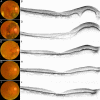Characteristics of pachychoroid neovasculopathy
- PMID: 33004959
- PMCID: PMC7530669
- DOI: 10.1038/s41598-020-73303-w
Characteristics of pachychoroid neovasculopathy
Abstract
Recently, several research groups have reported a newly recognized clinical entity of choroidal neovascularization, termed pachychoroid neovasculopathy. However, its characteristics have yet to be well described. The purpose of this study was to investigate the clinical and genetic characteristics of pachychoroid neovasculopathy regardless of treatment modality. This study included 99 eyes of 99 patients with treatment-naïve pachychoroid neovasculopathy. Mean initial best-corrected visual acuity (BCVA) was 0.20 ± 0.32 logMAR, and did not change (P = 0.725) during follow-up period (mean ± SD, 37.0 ± 17.6 months). Subretinal hemorrhage (SRH) (≥ 4 disc areas in size) occurred in 20 eyes (20.2%) during follow-up. Age, initial BCVA, central retinal thickness, SRH (≥ 4 disc areas in size) and treatment (aflibercept monotherapy) were significantly associated with the final BCVA (P = 0.024, < 0.001, 0.031, < 0.001, and 0.029, respectively). Multiple regression analysis showed initial BCVA and presence of SRH to be significant predictors of final BCVA (both P < 0.001). Polypoidal lesions were more common in the SRH group than in the non-SRH group (85.0% vs 48.1%, P = 0.004). There was no significant difference in the frequency of the risk allele in ARMS2 A69S, CFH I62V, CFH Y402H between these groups (P = 0.42, 0.77, and 0.85, respectively). SRH (29.1% vs 9.1%, P = 0.014) and choroidal vascular hyperpermiability (65.5% vs 43.2%, P = 0.027) were seen more frequently in the polypoidal lesion (+) group than in the polypoidal lesion (-) group. There was considerable variation in lesion size and visual function in patients with pachychoroid neovasculopathy, and initial BCVA and presence of SRH at the initial visit or during the follow-up period were significant predictors of final BCVA.
Conflict of interest statement
The authors declare no competing interests.
Figures




References
Publication types
MeSH terms
LinkOut - more resources
Full Text Sources
Miscellaneous

